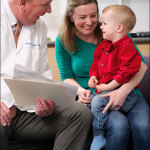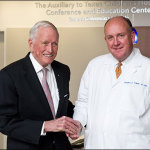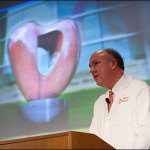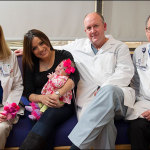 Bench and Bedside is a digest of the previous month’s stories about the clinical and academic activities of our physicians and scientists. We welcome your subsmissions and feedback.
Bench and Bedside is a digest of the previous month’s stories about the clinical and academic activities of our physicians and scientists. We welcome your subsmissions and feedback.
July 7
Texas Children’s Hospital launches pediatric Thyroid Tumor Program
Texas Children’s Hospital recently formed a new pediatric Thyroid Tumor Program dedicated to the diagnosis and treatment of children and young adults with thyroid tumors, cancer and diseases. Read more
Radiology expansion promotes environment of collaboration
New and improved office space for the Department of Pediatric Radiology brings together all radiologists in one large reading room and houses the department’s offices in one centralized location. The expansion also provides space for daily morning huddles. These changes help ensure the hospital’s imaging services are available for patients in a timely manner. Read more
July 14
Dr. Susan Blaney elected chair of CPRIT Advisory Committee on childhood cancers
Dr. Susan Blaney, deputy director of Texas Children’s Cancer and Hematology Centers, was recently elected to serve as chair of the Cancer Prevention & Research Institute of Texas (CPRIT) Advisory Committee on Childhood Cancers (ACCC). Blaney, who has been a member of the committee for three years, will serve a two-year term. Read more
Health Center staff prepares for transition to community hospital setting
With the opening of the outpatient and subspecialty building at Texas Children’s Hospital The Woodlands just 15 months away, steps are being taken to ensure the transition for staff, patients and their families is seamless. One such step was taken June 25 and 26 when staff and leaders at the Woodlands Health Center and staff and leaders at the West Campus Outpatient and Subspecialty Building met and discussed what it’s like to go from working at a small community health center to a community hospital. Read more
Texas Children’s opens first-of-its-kind pediatric Heart Failure Intensive Care Unit
Texas Children’s Heart Center and the section of Critical Care Medicine cut the ribbon July 6 on a new, first-of-its-kind pediatric Heart Failure Intensive Care Unit. This highly-specialized 12-bed unit focuses on the treatment of children with heart failure, as well as those requiring intensive care before and after heart transplant. Read more
July 14
Young investigator given research boost from national grant
Dr. Rikhia Chakraborty is a young scientist with a distinct goal – to find the causes that potentially lead to Langerhans cell histiocytosis (LCH), a rare cancer mainly affecting pediatric patients, and determine the best way to prevent and treat the disease. Chakraborty’s research was recently recognized by Alex’s Lemonade Stand Foundation with a Young Investigator Grant worth $100,000. Read more
Hour-long documentary on Mata conjoined twins to air on Discovery Life Channel
An hour-long documentary on the formerly conjoined Mata twins aired on the Discovery Life Channel on July 16 . The program spotlighted Texas Children’s Hospital’s efforts leading up to and after the historic surgery that separated Knatalye Hope and Adeline Faith Mata. Read more
Department of Surgery makes great strides 2010-2015
During his annual state of the department meeting, Surgeon-in-Chief Dr. Charles D. Fraser Jr. highlighted the impressive efforts within the Department of Surgery. Read more
July 20
A new community hospital partnership allows patients to deliver at CHI St. Luke’s Health – The Vintage Hospital
Pregnant members of Texas Children’s Health Plan – The Center for Children and Women Greenspoint location recently received some big news. They can now deliver their babies at CHI St. Luke’s Health – The Vintage Hospital located in Northwest Houston. Read more
Texas Children’s conference empowers HH patients, families
On July 11, Texas Children’s Hospital and Hope for Hypothalamic Hamartomas hosted an educational conference to empower patients and their families affected by a rare and often devastating brain condition. Hypothalamic Hamartoma (HH) is a noncancerous tumor of the hypothalamus that causes uncontrollable seizures, early puberty, hormonal imbalances and cognitive and behavioral problems. Read more
World renowned epileptologist, colleagues visit Texas Children’s Hospital
World renowned epileptologist Dr. Helen Cross and two of her colleagues visited Texas Children’s July 9 and July 10 to get more information on the Medtronic Visualase system, which uses real-time MRI-guided thermal imaging and laser technology to destroy lesions in the brain that cause epilepsy and uncontrollable seizures. Read more
Leaders prepare for opening of special isolation unit
Clinicians recently participated in a detailed simulation to prepare for the soon-to-be-open special isolation unit. The state-of-the-art facility will open its doors in October and a Special Response Team will stand ready to receive children suspected of having a highly contagious disease. Read more
End-of-treatment bell brings hope for cancer patients
Patients at the Texas Children Cancer and Hematology Centers now can ring a bell in both the inpatient and outpatient units at the end of their treatment. Listen to a song Purple Songs Can Fly artist and cancer survivor Christian Spear wrote and dedicated to patients entering a new phase of their lives with the ringing of the end-of-treatment bell. Read more
July 21
ICD-10: Let’s reach 100 percent educational compliance by September 1
On October 1, Texas Children’s and other hospitals around the nation will convert to the federally-mandated ICD-10 coding system to better report patients’ diagnoses and inpatient procedures. To ensure we are ready systemwide for this transition, employees must complete their required online education and training by September 1. You can access your assigned e-learning module here. Read more
July 28
Texas Children’s Auxiliary awards given to Gargollo and Rosenfeld
The Texas Children’s Hospital Auxiliary awarded urologist Dr. Patricio Gargollo the Denton A. Cooley Fellowship in Surgical Innovation Award and orthopedic surgeon Dr. Scott Rosenfeld the Outcomes Fellowship Award for 2015. Each award totals $75,000. This is the fourth year the Department of Surgery has received funding from the Texas Children’s Auxiliary. Read more
July 28
NRI study: Insufficient energy production by mitochondria can lead to neural degeneration
In a fascinating study recently published in PLOS Biology, Dr. Hugo Bellen, Manish Jaiswal and their colleagues at the Jan and Dan Duncan Neurological Research Institute at Texas Children’s found that insufficient energy production by the mitochondria can cause photoreceptor neurons in the retina to degenerate. Read more
July 28
Fraser celebrates 20 years with Texas Children’s Hospital Heart Center
Thanks to the vision of legendary heart surgeon Dr. Denton H. Cooley and the leadership of Texas Children’s Hospital Surgeon-in-Chief Dr. Charles D. Fraser Jr ., the Texas Children’s Hospital Heart Center is one of the most active pediatric heart programs in the United States, setting a record with 32 heart transplants in 2014 and consistently treating the most complex heart issues every day. Read more
Texas Children’s expands crucial care to cancer and hematology patients in developing countries
Texas Children’s Cancer and Hematology Center physicians are crossing the globe to provide care for children suffering from cancer and blood disorders. Watch a video to see how the care they provide continues to reach new populations. Read more
July 28
Zarutskie’s arrival, expertise complements patient care at Family Fertility Center
Dr. Paul Zarutskie recently joined the Family Fertility Center at Texas Children’s Pavilion for Women. With more than 30 years in the field of reproductive medicine, Zarutskie combines his expertise and compassionate approach to patient care to help infertile couples achieve their dream of starting a family. Read more
August 14
Transplant Services team to host pediatric transplant symposium
Texas Children’s Hospital Transplant Services team is hosting the 2015 Pediatric Transplant Symposium at Texas Children’s Hospital. Learn how to register for this conference. Read more






















